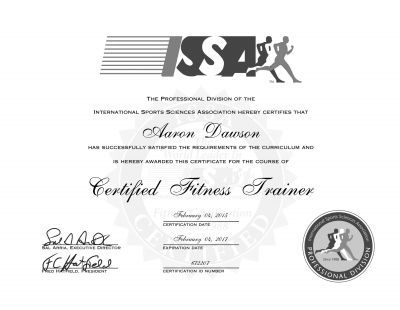What is an Athletic Trainer?
An athletic trainer is someone who works with your general physician when you get hurt physically, for example if you sprain your ankle or injure your back.
This specially trained professional will treat and prevent athletic injuries, help to reduce your pain, and improve your mobility before, during, and after an injury.
These people sent from above will teach you how to exercise and play sports properly, so you don’t hurt yourself any more than you previously have.
You’ll want to stay close to your athletic trainer when working out, because they know how the body is supposed to move, and the best ways to prevent injuries.
Duties
With any job, there are going to be things that an athletic trainer has to do on a daily basis.
Some of these duties involve other people like clients, and some involve working with doctors and nurses to talk about patients.
It is important to always remember to have good communication skills with each duty.
- Assess injuries and evaluate treatment
- Understand anatomy and physiology
- Awareness of Nutrition
- Treat disabilities
- Manage injuries and illnesses
- Understanding of interpersonal skills
- Prevent injuries
- Understand pharmacology
Average Salary
As of 2019, the average athletic trainer makes around $45,000 annually.
The range falls between $41,000 and $51,000 depending on experience and education.
Those that have a lot more training are going to make more money.
Usually, when you first start out as an athletic trainer, you will be at the bottom of the average salary.
When you work your way up, get more education and specialties, that’s when you’ll be able to see more money.
You can even open your own facility in order to make more money.
If that’s your plan, make sure you get the proper education in business as well.
Annually National Average Salary: $61,540
Average Annual Salary by State
| State | Avg. Annual Salary |
|---|---|
| Alabama | $53,590 |
| Alaska | $70,580 |
| Arizona | $64,890 |
| Arkansas | $51,500 |
| California | $72,840 |
| Colorado | $64,520 |
| Connecticut | $63,380 |
| Delaware | $56,270 |
| District of Columbia | $89,720 |
| Florida | $56,480 |
| Georgia | $66,270 |
| Hawaii | $60,800 |
| Idaho | $64,450 |
| Illinois | $72,320 |
| Indiana | $55,380 |
| Iowa | $51,970 |
| Kansas | $52,710 |
| Kentucky | $53,150 |
| Louisiana | $54,980 |
| Maine | $57,890 |
| Maryland | $61,400 |
| Massachusetts | $66,550 |
| Michigan | $57,500 |
| Minnesota | $62,050 |
| Mississippi | $52,670 |
| Missouri | $55,480 |
| Montana | $55,230 |
| Nebraska | $58,760 |
| Nevada | $49,240 |
| New Hampshire | $55,900 |
| New Jersey | $77,540 |
| New Mexico | $65,160 |
| New York | $71,410 |
| North Carolina | $52,700 |
| North Dakota | $55,000 |
| Ohio | $58,550 |
| Oklahoma | $66,130 |
| Oregon | $67,960 |
| Pennsylvania | $56,780 |
| Rhode Island | $60,990 |
| South Carolina | $56,850 |
| South Dakota | $52,720 |
| Tennessee | $56,450 |
| Texas | $64,040 |
| Utah | $61,260 |
| Vermont | $59,960 |
| Virginia | $65,720 |
| Washington | $59,110 |
| West Virginia | $46,590 |
| Wisconsin | $61,120 |
| Wyoming | $52,970 |
Annual Average Salary: Top 5 States
The top earning state in the field is District of Columbia, where the average salary is $89,720.
These are the top 5 earning states in the field:
Conducted by: Bureau of Labor Statistics, Department of Labor.
* Employment conditions in your area may vary.
How to Become an Athletic Trainer
Step 1Get Educated
The job of an athletic trainer may look easy, but it actually takes a lot of skill and schooling in order to work as a certified trainer, especially if you want to work with doctors to treat diseases like diabetes and issues like obesity.
After you graduate high school, you’ll want to apply at the college of your choice.
Soon, you’ll be on your way to getting a Bachelor’s degree.
Your best bet is to obtain a Bachelor’s degree in athletic training.
Some of the types of classes that you will take in this field are physiology, anatomy, injury and illness protection, and human movement science.
The most important factor (besides grades of course) is that the school you go to is accredited with the Commission on Accreditation of Athletic Training Education.
This way, you’ll be able to get your license.
Step 2Become Experienced
Just like any other field, you’re going to want to get as much practice as you can before you start making the big bucks.
It’s possible that future employers may hire you without experience, but chances are that getting some experience while in school will help you in future job prospects.
There is always hands-on training, health programs, internships, and workshops to do while in school.
Keep up to date with cutting edge training and education while you get your experience.
Some of the things you want to take to heart are:
- Obtaining employment information
- Mastering new athletic training procedures
- Expanding your approach
- Conducting your practice in an ethical and appropriate manner.
Step 3Obtain Your License
In order to work as an athletic trainer, you need to be licensed.
The requirements to be eligible for your license include completion of an accredited program and passing the certification exam.
Once you do that, you’ll be licensed and ready to work.
Don’t forget that your license does expire, so you’ll want to keep up to date on all certifications.
Find your local NATA, or National athletic trainers Association to find out more about what you need to do to get licensed.
Before you get licensed, make sure you understand:
- How to prevent injury or illness
- How to examine and diagnose patients
- An understanding of Emergency Care
- Training in health care administration
Step 4Get a Master's
Why stop at just a Bachelor’s degree?
With a Master’s you’ll be at the top of your career, where much advanced placement is available.
Some of the programs you can get into with a Master’s degree include sports medicine, exercise physiology, and advanced athletic training.
Obtaining a Master’s degree can open up so many more doors for you, especially if you get a degree in business as well.
Though it is not necessary to get a Masters degree as an athletic trainer, the experience and education you receive can put you leaps and bounds above the rest.
It is even possible to obtain a Master’s degree in Athletic Training if you have a Bachelor’s degree in another field.
Don’t sell yourself short, sometimes we have a change of heart after we get our education.
Education
In order to become an athletic trainer, you must have a bachelor’s degree in athletic training.
The school that the AT graduates from must be accredited so that they can obtain licensing.
There are several ways to find an accredited school, if you are unsure, ask the counselor at the school you are looking to apply.
They should be able to help you, and if not, contact NATA, the National athletic trainers Associate, they can help as well.
A Bachelor’s degree can take roughly four years to complete, but this includes general education classes as well.
When you are looking to obtain a Bachelor’s degree, there are three different types of degrees that are accredited.
If you achieve an accredited degree, this means that you’ll be eligible to take the certification test and become licensed.
Some people choose to go to graduate school to obtain a Master’s Degree.
When you gain a Master’s degree, you open up so many more doors.
Along with your degree, you can also get tons of training through workshops, conferences, and continued training.
It is even possible to do some training and education online.
Just make sure that your online training or education is accredited.
This is voluntary, but may open the job market even more.
Video About The Career
Licensing
It is important that the school you attend for AT is accredited with the Commission on Accreditation of athletic training Education.
The CAATE is available in all states, though some states do not require licensure.
You’ll become eligible for the exam in your final semester of classes.
If you do not pass, the test you are able to take it again as many times as needed.
Please do your research on the state that you live in to find out what the accreditation requirements are for where you live.
A license is required in 49 states and in the District of Columbia, so make sure you take that test and pass.
There are some states that allow you to take a certain training program if you already have a Bachelor’s or Master’s degree in a separate field.
Though you still have to take the test to become a certified trainer.
One of the most important things to remember is that you are going to need to be re-certified every couple of years.
The timeline for re-certification depends on the state that you live and the requirements for that state.
You’ll also want to check with your employer about re-certification details.
Certification Example:

Average Training Program Duration: 4+ Years
It can take between 4 and 6 years to become an athletic trainer.
Those that wish to obtain a Bachelor’s Degree can do it in four years, as long as they do their on the job training while they are in school.
Those that plan to get a Master’s Degree will typically take about six years to complete the program.
Popular Programs
Job Outlook
The job outlook for an AT is great.
There are positive steps going for this career path in the future.
More middle-aged and older people are staying active, which means more injuries can occur.
There are many AT’s that are needed in schools and hospitals.
Employment Growth Projection: 23%
2020
2030
That's a higher than average projected growth of 7,000 jobs.
Athletic Trainer: Interest Over Time
Should You Become an Athletic Trainer?
Overall Satisfaction: High

Those that have a passion for sports and love to help people will get the most satisfaction out of this job.
People that work as athletic trainers say that their job is satisfying.
The hours can be long, but helping people is worth it.
Depending on the place that athletic trainers work, they can also have varying degrees of satisfaction.
For example, those that work in hospitals have a more stressful job, but those that work in gyms or typical doctor’s offices find it less stressful.
Hospital jobs may require you to work nights and weeks, while doctor’s offices may make you work only during office hours.
Average Salary: High

The average yearly salary for an athletic trainer is $45,000.
Those that are just starting out with minimal experience can make around $41,000.
People who have worked for years and have experience, education, and skills can make over $50,000.
When you first start out at your job, you will likely make lower than average, but as you work your way up and get more experience, you will be toward the top of the average salary scale.
It is important to remember that skills and training will get you to the top.
Don’t get discouraged if you don’t make as much as the average athletic trainer.
Job Growth Outlook: High

Within the next 10 years, the demand for athletic trainer’s looks to be growing 23%.
Many people are becoming more aware of the effects of athletics and exercising.
Also, the middle-aged population is staying active longer, which means more injuries are possible.
More people are turning to professionals to help with injuries, rather than taking care of it themselves or talking to a general physician.
It is important for people to keep themselves safe and not cause further injury, with the help of an athletic trainer, clients are positive they won’t injure themselves.
Some companies and schools are using athletic trainers when they open gyms on campus, which can help with jobs in the future.
Education Duration: 4+ Years

It can take between 4 and 6 years to become an athletic trainer.
Those that wish to obtain a Bachelor’s Degree can do it in four years, as long as they do their on the job training while they are in school.
Those that plan to get a Master’s Degree will typically take about six years to complete the program.
Education is important when you become an athletic trainer, the more you learn about the human body, the better you will be at success in the job.
Personal Skills Needed

This job isn’t for everyone, and it’s important to make your clients feel comfortable and welcome, so some of the personal skills that athletic trainer’s should include:
- Empathy for other people’s illnesses and injuries
- Compassion for clients, especially those who are hurt
- Interpersonal skills like maintaining eye contact, listening and asking meaningful questions
- Ability to make your own decisions and decisions for others
- Attention to detail, you are dealing with precious cargo, people’s bodies.
- Confidence in yourself and your education
Frequently Asked Questions
Q. How much does an athletic trainer make?
On average an athletic trainer makes around $45,000 a year.
It’s possible when you start out that you will make less, but as you gain experience, you’ll begin to make more money.
Those that are just starting out will probably make less than the average yearly amount.
Those that gain education and skills will quickly work up the salary ladder.
Q. What does an athletic trainer do?
An athletic trainer works with doctors, schools, and athletic corporations to ensure that athletes and people who participate in athletics are safe.
athletic trainers take care of injuries, prevent injuries, and teach people how to exercise that they don’t hurt themselves.
athletic trainers have a professional understanding of the human body, muscles, joints, and what can hurt a person’s body further.
Q. How long does it take to become an athletic trainer?
It can take between 4 years, when you get a Bachelor’s and 6 years, when obtaining a Master’s degree.
The education may take longer if you do not do training while in school, because most employers (though not all) require some type of experience before hiring you.
It is also possible to get your license while you are still in school, which can cut down on the time it takes to get into a career.
Q. Is there a demand for athletic trainers?
Yes, there is quite the demand for athletic trainers, especially in schools and hospitals.
When new facilities like doctor’s offices, gyms, and hospitals open, there are many new positions for athletic trainers.
People are become more health conscious, and want to make sure that they are not hurting their bodies while working out.
They also want to make sure that they aren’t going to injure themselves further.
Being an athletic trainer is important, and will need to be in more facilities as the years go on.
Q. How much does it cost to become an athletic trainer?
This really depends on where you plan to go to school.
Most four-year colleges range between $35,000 and over $100,000 a year.
Obtaining a Master’s degree can add on even more to that number.
Though this may not be a very cheap degree, it is important and there is a high demand for this type of job.









